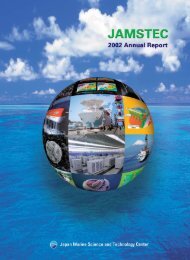2007 Annual Report - jamstec japan agency for marine-earth ...
2007 Annual Report - jamstec japan agency for marine-earth ...
2007 Annual Report - jamstec japan agency for marine-earth ...
Create successful ePaper yourself
Turn your PDF publications into a flip-book with our unique Google optimized e-Paper software.
(4) Outline of Activities of Kochi Institute <strong>for</strong> Core<br />
Sample Research<br />
1 Outline of Activities<br />
On the start of international operation of the deep-sea<br />
drilling vessel Chikyu, the Kochi Institute <strong>for</strong> Core Sample<br />
Research was established in October 2005 as a research institute<br />
with combined responsibilities including operation of a<br />
refrigerated core repository <strong>for</strong> storage of core samples. As a<br />
Photo 5 Marine Environment Monitor <strong>Report</strong> Meeting (February 5,<br />
2008)<br />
result, it carries out activities as the nucleus research center <strong>for</strong><br />
the series of processes in connection with analysis and research<br />
on core samples and safekeeping of the samples. At present, the<br />
Kochi Institute comprises three research groups, the Science<br />
Services Group, and the General Affairs Division.<br />
Photo 6 Scene during a visiting lesson at Wakinosawa Elementary<br />
School in Mutsu City<br />
5 Record of Media Presentations, Etc.<br />
FM radio program (weekly broadcasts)<br />
Introduction of technologies related to the Mutsu Institute by<br />
the Too-nippo Seeds Series (throughout the year)<br />
Results of time-series observational research in the North<br />
Pacific (April), “World's First Successful Long-term,<br />
Automatic Sampling of Seawater - Expectations <strong>for</strong> an<br />
Elucidation of the Mechanism of Absorption of CO 2 by<br />
Seawater - ”<br />
Results of “Development of an Oceanic CO 2 Sensor”<br />
(June)“Start of Actual Ocean Testing of Compact Ocean<br />
Surface Layer CO 2 Partial Pressure Observation Device - A<br />
Large Advance toward to the Realization of Low-cost, Longterm<br />
Automatic Observation of the Distribution of CO 2 in the<br />
Surface Layer of Oceans - ”<br />
6 Other Activities<br />
Visiting lessons at three elementary and middle schools in<br />
Wakinosawa/Kawauchi District in Mutsu City (November)<br />
Receiving of one middle school student <strong>for</strong> work experience<br />
(August)<br />
Receiving of three high school students <strong>for</strong> work experience<br />
(September)<br />
Marine environment monitoring measurements of<br />
Sekinehama and Noushi with the cooperation of Aomori<br />
Prefecture (throughout the year)<br />
2 Research Activities<br />
(1) Physical Properties Research Group (Fault Research)<br />
The Physical Properties Research Group is in engaged<br />
research with the aim of achieving a comprehensive understanding<br />
of <strong>earth</strong>quake faults based on material science, which<br />
includes promoting <strong>earth</strong>quake fault drilling science in the<br />
Nankai Trough Seismogenic Zone Experiment (NanTroSEIZE),<br />
Taiwan Chelungpu Fault Drilling Project (TCDP), etc., and<br />
measurements of various physical and mechanical properties<br />
and measurements of stress/strain, etc. of core samples containing<br />
fault rocks. In FY <strong>2007</strong>, the group clarified the structures of<br />
anomalies and fault zones with high magnetic susceptibility and<br />
high water contents which occurred due to fault slippage in<br />
faults zones by analysis of drilling samples from the Taiwan<br />
Chelungpu Fault, and based on this, traced the mechanism of<br />
occurrence of high magnetic susceptibility in laboratory experiments<br />
and other research. The group also discovered that the<br />
principal stress direction in the vicinity of a fault zone changes<br />
by image analysis of core samples and the borehole wall, and<br />
thus succeeded in obtaining important evidence <strong>for</strong> designation<br />
of the fault which slipped in the 1999 Chi-chi Earthquake.<br />
These results were compiled and presented in more than 10<br />
papers in international journals.<br />
The Physical Properties Research Group is also actively<br />
participating in the Nankai Trough Seismogenic Zone<br />
Experiment which began in the autumn of <strong>2007</strong>. The group has<br />
proposed various types of post-cruise research, and requested<br />
and received samples. At the end of FY <strong>2007</strong>, the group began<br />
research using samples from the Nankai drilling. As shipboard<br />
research, researchers measured nonelastic strain using core<br />
samples from Nankai trough drilling, and were able to obtain<br />
secular change curves <strong>for</strong> strain having sufficient accuracy <strong>for</strong><br />
stress analysis. The group also developed/introduced devices<br />
<strong>for</strong> simple, high accuracy measurement of various basic proper-
















